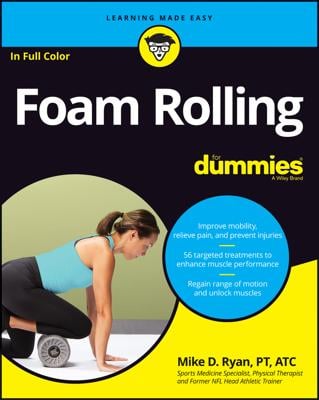The term foam rollers is generally used to describe all rollers. However, the standard round “foam” roller is just one type of roller you can use to unlock your muscles, increase your joints’ range of motion, strengthen your core muscles, and improve your body’s health.
Because rollers have such a wide range of uses, no one roller will meet all of your needs. Rollers can be used to treat the spine, shoulders, upper extremities, core, hips, and lower body. Based on the wide range of muscle sizes and body variations, different roller sizes, shapes, and textures can be used throughout the body.If you’re a beginner, start with the basic cylindrical foam roller. It’s softer, more stable, and more comfortable for introducing someone to proper roller techniques. It may not be as effective for treating smaller, more localized trigger points, but you should start slower as you learn how to roll and unlock larger muscles on a more comfortable standard roller.
Circular rollers: Keeping it simple
The most basic of rollers is the round cylinder roller, shown in the following figure. Most of them are made of foam. Their diameter is typically 6 inches, while their length can range from 12 inches to 4 feet. Because they are larger and made of a softer material, they will be more comfortable for rookie rollers and those managing more painful ailments.Learning all the nuances of rolling will take some time. Learning on a softer and more comfortable roller like a standard circular foam roller will help accelerate or steepen “the learning curve.”
Some discomfort can be expected when rolling on tight muscles and trigger points. Using softer rollers with a proper technique will help. Harder rollers with a multi-pattern texture isolate the pressure, which can be more uncomfortable.
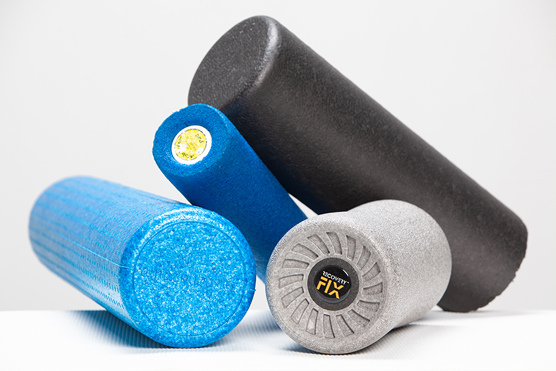 Photography by Haim Ariav & Klara Cu
Photography by Haim Ariav & Klara CuCircular rollers come in various sizes and lengths.
Pro: Softer, more comfortable, larger pressure surface, easy to balance, less expensive.
Con: Less depth of pressure, less localized treatments.
Multi-pattern design rollers
A multi-pattern roller is usually the same diameter, six inches, as the basic foam roller, but its surface is very different. As the name suggests, the rolling surface of a multi-pattern roller is not flat. Instead, these rollers are covered with ridges, pressure pads, and grooves. They often look more like a truck tire than a roller. The inner core of the roller can be foam, hard plastic, or hollow.The purpose of these rollers, which are shown in the figure, is to apply more localized pressure on trigger points and scar tissue within skin, muscle, tendons, and fascia while rolling. With its many ridges and angled peaks, a multi-pattern roller allows you to maneuver the peaks of the roller into and around uneven muscles, tendons, and fascia.
These rollers are effective at improving tissue mobility yet are more painful during rolling. Unlike the softer foam roller’s broad surface, which is applied to a bigger, wider area over a muscle, this varied surface will apply pressure to a smaller, isolated area. Think about the difference between a steak knife and a butter knife. The point of a steak knife has a much smaller contact spot. This makes the knife “sharper” and more painful if applied to your skin.
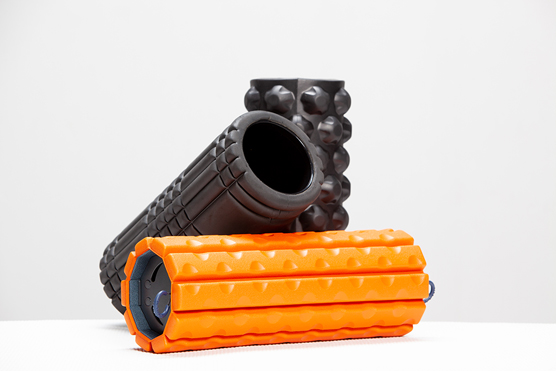 Photography by Haim Ariav & Klara Cu
Photography by Haim Ariav & Klara CuMulti-pattern rollers provide varying surfaces to treat muscles.
Pro: Versatile for treatments, more hard-core for heavier body parts.
Con: Not useful for workouts, more painful, moderately more expensive.
Vibrating rollers
“Long Roller and Roller Ball, I’d like to introduce you to Mr. Massage.” Here’s where high-tech merges with rollers and roller balls. These heavenly tools combine the many benefits of rollers while adding the relaxing effects of a vibrating massage.These rollers come in many shapes, from the cylindrical shape to the ball shape shown in the following two figures. They have varied degrees of control, such as vibration intensity, programmable waves of vibration, and heat to individualize your rolling experience.
Following are some benefits of vibration therapy:
- Improved circulation
- Decrease in muscle soreness
- Increased soft tissue flexibility
- Improved lymphatic drainage
- Increased tissue temperature
Tight tissue is typically unhappy tissue. Relaxed, warm, flexible tissue with a rich supply of healthy blood is typically happy tissue.
The cool part about vibrating rollers like the ones shown is that they can also serve as effective rollers without the vibration component turned on. Normal rolling techniques and principles can still be applied if you don’t want to use the vibrating element.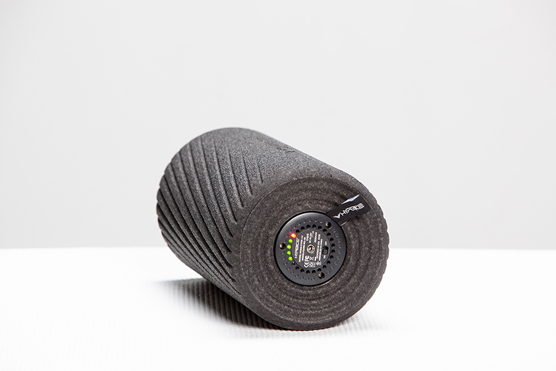 Photography by Haim Ariav & Klara Cu
Photography by Haim Ariav & Klara CuCylindrical vibrating roller.
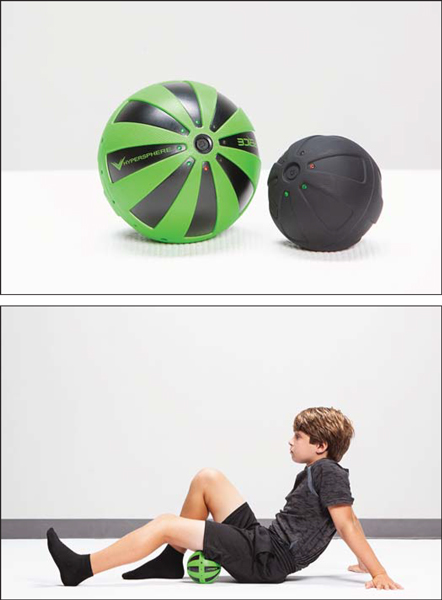 Photography by Haim Ariav & Klara Cu
Photography by Haim Ariav & Klara CuRound vibrating rollers, large and small
Pro: Relaxes body tissue, improved comfort while rolling, versatile for treatments.
Con: More expensive, makes balance more difficult, less useful for workouts.
Roller balls
When it comes to applying localized pressure on an area of your body, it’s hard to beat roller balls. Because of their round contact points and varied sizes (shown in the following figure), roller balls apply concentrated pressure exactly where you need it to unlock a muscle or relax a trigger point.Roller balls are especially useful for smaller muscles in parts of the body that are more compact. These areas include hands, forearms, shoulders, hips, and feet. You could roll these body parts with a larger roller to warm the area up before you exercise. But if you want to treat those busy areas of the body, a roller ball is the perfect device.
Unlike a typical roller, a roller ball can move in any direction. Where a standard roller functions like a steamroller as it rolls up or down a body part, a roller ball can change direction at any time with a 360-degree range. This hyper mobility is especially helpful when seeking multiple trigger points within a busy area of the body.
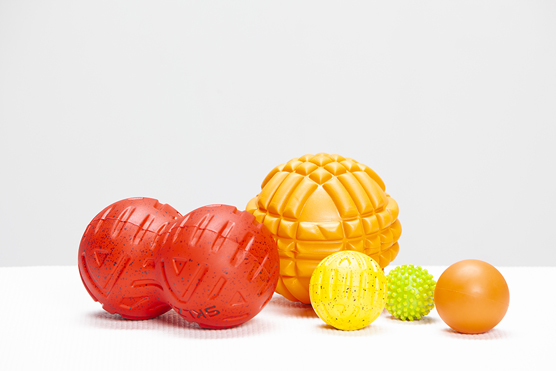 Photography by Haim Ariav & Klara Cu
Photography by Haim Ariav & Klara CuWith their round shape and various sizes, roller balls provide very localized treatments.
It’s important to note that more isolated pressure often means a more intense and uncomfortable treatment.
Pro: Isolated pressure, more dynamic treatments.Con: More intense treatments, not useful for workouts.
Half rollers
Half rollers, shown in the following figure, are foam rollers cut in half the long way. The result is a very stable and versatile tool for both treatments and exercise.For patients who are new to rolling or those who are challenged by balancing on a roller, they are perfect companions. Using half rollers for your shoulders and hips provides a stable roller to relax tight muscles allowing for a deeper treatment. Typically, their surface texture is limited, but that does not take away from the many benefits of treating and exercising on a half roller.
If you’re doing a treatment on a roller and you’re having difficulty maintaining perfect form and relaxing, move to the half roller to improve your technique. This will allow you to breathe normally, maintain perfect positioning on the roller, and unlock your muscles. As you master this technique, you will probably be able to return to a more advanced roller.
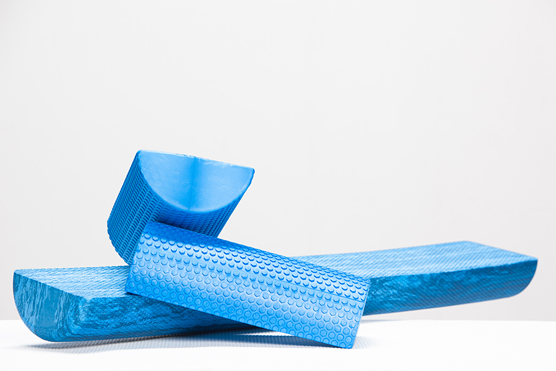 Photography by Haim Ariav & Klara Cu
Photography by Haim Ariav & Klara CuA half roller adds stability to the standard roller.
Pro: Stable, easier to use, allows longer position holds for postural corrections.
Con: Less dynamic treatments and workouts.
Travel rollers
As the name suggests, travel rollers (shown) are collapsible and easy to bring with you on the road. With a simple pull of the strings, the skinny pad is quickly transformed into a stable and functional roller.The travel roller from Brazyn Life offers smooth or multi-patterned surface options. The smoother surface is used like a standard roller with larger contact areas. This allows you to relax larger muscles and larger trigger points. The multi-pattern surface provides multiple contact areas for a deeper treatment.
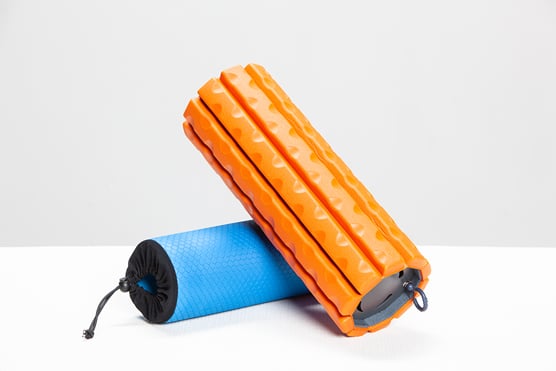 Photography by Haim Ariav & Klara Cu
Photography by Haim Ariav & Klara CuA travel roller transforms from a slim travel mate to a solid roller.
Pro: Smaller size for travel.
Con: Expensive, fewer size options.

